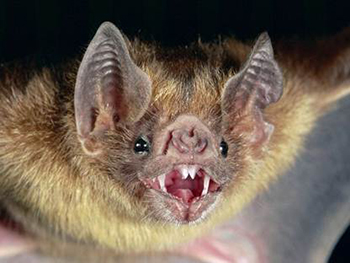Vampire Bat
Desmodus rotundus

Taxonomy:
Kingdom – Animalia
Phylum – Chordata
Class – Mammalia
Order – Chiroptera
Family – Phyllostomidae
Genera – Desmodus
Species – Rotundus
Description:
The Chiroptera is the second largest mammalian order with approximately 202 genera and over 1,120 of living species. The vampire bats are dark gray or brownish in color on the head and back with paler undersides. These bats generally have small ears and a short tail. Its front teeth are specialized for cutting and the back teeth are much smaller than in other bats. The dental formula is 2/3, 1/1, 3/3, 3/3 = 38 total teeth. Many of the most important diagnostic features of bats are adaptations to flight and involve integrated functional and structural modifications of the body. Many such adaptations are morphysiological, such as the demand for synchronized respiration and echolocation in flight. Wingbeats must be coordinated with breathing, and breathing must be coordinated with sound production. As a result of these interrelated functions, bats have evolved the largest hearts and lungs relative to body size of all mammals.
Food:
Vampire bats find their prey by using a combination of smell, sound, and echolocation. Using echolocation, the bats emit high pitched sounds. Then interpret the sounds echo to determine location and distance. In the process of searching for food, they may fly only three feet from the ground to an exposed area of an animal and then painlessly cut away a small piece of skin. The tongue has an anticoagulant to keep the blood flowing and prevent it from clotting while they are feeding. They feed for about 30 minutes, but do not remove enough blood to harm their host. However, their bites may lead to possible infections. Despite contrary belief, vampire bats do not suck the blood, but rather lap it up with their tongues. They mainly prey upon cows, horses, and birds. Very rarely they will feed on humans.
Habitat:
You will find these bats in arid and humid areas of the tropics and sub tropics. They usually inhabit caves but can also be found in hollow trees, old wells, mine shafts and abandoned buildings all depending on the size of the group. Vampire bat colony numbers can range into the thousands in roosting sites. Another unique adaptation of vampire bats is the sharing of food. A vampire bat can only survive about two days without a meal of blood, yet they cannot be guaranteed of finding food every night. This poses a problem, so when a bat fails to find food, it will often "beg" another bat for food. The "host" bat may regurgitate a small amount of blood to sustain the other member of the colony.
Intra Species Interaction:
Vampire bats are the only species believed to “adopt” the young if something happens to the bats mother. Another unique adaptation of vampire bats is the sharing of food. A vampire bat can only survive about two days without a meal of blood, yet they cannot be guaranteed of finding food every night. This poses a problem, so when a bat fails to find food, it will often "beg" another bat for food. The "host" bat may regurgitate a small amount of blood to sustain the other member of the colony. Vampire bats also engage in social grooming. This is much more prevalent in females, but does occur in males as well. Usually social grooming is associated with food sharing.
Reproduction:
Among species that have been extensively studied, many have annual cycles of sexual activity, including the vampire bats. The cycles of entire populations are synchronized so that nearly all mating occurs within a narrow time frame of a few days or weeks. Vampire bats are promiscuous, meaning that mate with several others. The female bats migrate to special nursery roosts where they are joined by hundreds of other pregnant females. These roosts are generally warmer which may speed up the development in the womb. The gestation period of the bat is relatively long, ranging anywhere from 40 days to 8 months. Just like humans, bats tend to give single births more than any others, with the occasional set of twins. Bats are born bottom first, an arrangement that minimizes the chance of the wings getting tangled in the birth canal.
Ecological Impact:
The vampire is so abundant in some parts of the tropics that it is considered a nuisance. The bites themselves do not hurt livestock, but the infection and complications from the bite can potentially taint the meat.
Recent Research:
Saliva from vampire bats has recently been found to be able to break up blood clots in the brain potentially deterring strokes. The saliva contains a special kind of protein that thins the blood that keeps it from coagulating. The trial is currently taking place in 40 hospitals across the UK, with 400 patients receiving the new drug. Doctors said that if the trials are successful, the treatment could become widespread within three years.
Personal Interest:
I chose to do the vampire bat because is it somewhat of a cultural icon for dark things. I also took Mammalogy Spring 2012, and the entire Chiroptera Order was what I found I was really interested in.
References:
Please note that the following references may have either been removed or relocated by the webpage owners since the time this student report was created.
"Vampire Bats." National Geographic. Web. 01 June 2012. <http://kids.nationalgeographic.com/kids/animals/creaturefeature/vampire-bat/>.
Vaughan, Ryan, and Czaplewski. Mammalogy 5th Edition. Jones and Bartlett Publishers. 2011.
"Saliva From Vampire Bats May Aid Stroke Victims, Research Shows." Fox News. FOX News Network, 04 Sept. 2011. Web. 30 May 2012.< http://www.foxnews.com/health/2011/09/04/saliva-from-vampire-bats-may-aid-stroke-victims-study-shows/>.
http://images.nationalgeographic.com/wpf/media-live/photos/000/005/cache/common-vampire-bat_505_600x450.jpg
http://cdn2.arkive.org/media/CD/CD97FC4D-BC9A-442B-AB68-33A26AF221FF/Presentation.Large/Common-vampire-bat-with-tongue-extended-as-feeding.jpg